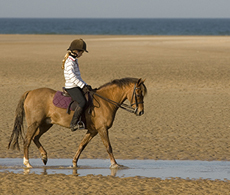
Post-lockdown checklist: Is your horse ready to go back to work?
For many of us, lockdown has brought about an enforced break for our horses, with many being turned out for a few weeks. Now that restrictions are lifting, many of us are keen to get back in the saddle. Vet Sarah Hunter explains how to safely get our horses back in shape and what checks you need to make before you start work.
Our expert
Sarah is an equine vet at Clevedale Vets in North Yorkshire. She graduated from the Royal Veterinary College, London in 2012 and is currently working towards a certificate in Advanced Veterinary Practice. In her spare time, she enjoys exploring her local area through riding and running.
Getting the all-clear from your vet
When considering bringing a horse back into work after a break, a good place to start would be to ask your vet to perform a check-up to assess for any signs of pain or lameness. A thorough assessment would include:
- looking inside your horse’s mouth to check his teeth (a dentist may be required)
- listening to his heart and lungs
- feeling his legs for lumps and bumps (we recommend owners do this daily as a good habit)
- looking at the hoof shape and quality
- weighing your horse and assessing his condition
- feeling his back for areas of pain or tight muscles
- watching your horse in walk and trot.
It’s really important to check that there are no signs of pain in these areas before you start working. Exercise could make any niggles or existing problems worse, resulting in your horse being reluctant to work or showing behavioural signs such as napping or bucking.
Extra checks for your horse
Now is also a great time to get your farrier, physio and saddler out to check over your horse.
1. Get his feet checked and balanced
As farriers have only been able to carry out essential work, it may have been a while since your horse has had his feet trimmed and they may have become overgrown or developed uneven wear. Overgrown feet are more likely to become damaged and develop cracks, allowing infections to develop. You should give cracks or defects time to repair themselves before starting work, and severe damage may need remedial farriery or changes to the environment and additional feed supplementation. Hoof balance is also vital, so ask your farrier to assess how balanced your horse’s hoofs are and make adjustments to his trimming and shoeing as necessary.
2. Does he need physical therapy or bodywork?
Your vet will work alongside physical therapists such as physiotherapists and osteopaths, and may refer your horse if they feel there is a problem that needs resolving.
3. Check your saddle fits
Perhaps one of the most important things to check before climbing on-board your horse is the fit of his saddle. Horses are constantly changing shape, meaning that his saddle may not fit as well as it did, especially if he has put on a few pounds or lost some muscle mass. A poorly fitting saddle can cause untold damage, so it’s vital to get it checked by a professional saddle fitter prior to starting work.
4. Is your horse a healthy weight?
When we see our horses every day, it’s hard to notice any changes in weight and condition, so taking a weight measurement with a weight tape every week and body-condition scoring is a handy way of monitoring any changes. An increase in weight can not only affect the way the saddle fits, but it can also cause back pain and lameness and increase the risk of laminitis. Being overweight can also make the horse more prone to exhaustion and heat stress.
5. Think before upping his feed
Just because you’re starting to work your horse again doesn’t mean that you need to increase his hard feed. If your horse has gained a little weight, this stored-up energy will be enough for him to carry out the work required of him. Just make sure that he is receiving a good-quality balancer alongside his usual hay or grass to ensure he is receiving all the vitamins and minerals required for a balanced diet. If he feels like he’s lacking energy, focus on building up his fitness levels instead of looking for a short-term fix in the form of a high-energy feed that will likely just make him fatter.
Getting back in the saddle
Once your horse and his saddle have been given the all-clear, it’s time to get going.
- Start with short riding sessions and gradually build up the duration and intensity of exercise to reduce the risk of injury. Hacking in walk for 15-20 minutes and increasing as he gets fitter is a good way to build up his muscles while working in straight lines.
- Lunging your horse without a rider can be a good way to get him used to carrying his tack again and build up his back muscles. Limit sessions to five to 10 minutes on each rein to start with.
- Give your horse ample time to warm up and cool down in each session and be careful of doing too much, too soon.
- Keep assessing your horse – if he seems stiff and sore after a session, you have possibly done too much, and a few gentle days with a light hack or some stretching exercises will see him right.
- To reduce the risk of heat exhaustion, try riding during cooler parts of the day and only ask your horse to carry out work suitable for his level of fitness.
Don’t forget about yourself! Even if you’ve managed to keep fit while you’ve not been riding, being ‘riding fit’ is sometimes a different story altogether. Check out our article on pilates for horse riders and try these warm-up and cool-down stretches before and after you ride.


